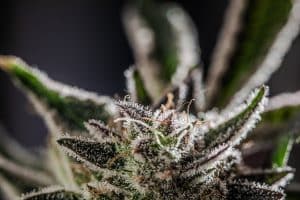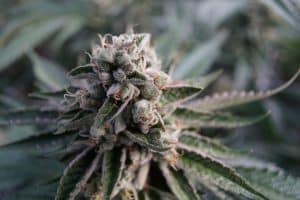Albinism, the absence of color in certain cannabis plant sections, is rare and intriguing. This genetic disease impairs chlorophyll formation, which is necessary for photosynthesis, resulting in albino or partially albino cannabis plants. Affected plants have ghostly leaves, stems, and buds without a green hue. Albino cannabis plants have pale yellow or white tissue that cannot photosynthesize. These plants are weaker, smaller, and more vulnerable to environmental stressors, making them difficult to grow. Albino cannabis plants are rare and unique; thus, researchers and collectors are interested in them. They are valued for their decorative beauty and breeding potential, but their lower vigor and production potential make large-scale cultivation impractical. Albino cannabis growers frequently love their plants and take extra care to ensure they live and produce albino offspring.
Different Types of Albinism in Cannabis
Albinism in cannabis plants can range from entirely albino to variegated. This genetic abnormality is most noticeable in fully albino cannabis plants. These plants have no green pigmentation because chlorophyll synthesis is nearly nonexistent. Fully albino cannabis plants have ghostly pale yellow or white leaves, stems, and buds. These plants are weak, tiny, and vulnerable to external disturbances due to photosynthetic failure. Fully albino cannabis plants are rare and beautiful, but they are difficult to grow and rarely produce healthy offspring without special care.
Partial albinism, or variegated plants, have normal green pigmentation except for select leaves or buds that lack chlorophyll and are white or pale. Variegated cannabis plants can survive and develop buds because they can still photosynthesize in green patches. These plants’ variegated and green portions create a striking contrast that attracts collectors and cultivators of uncommon and attractive cannabis.
Causes of albinism in cannabis plants
There are several reasons why your cannabis plant could exhibit albinism-related traits. Here are a few causes of albinism in cannabis plants:
Genetics
Similar to human albinism, plant albinism is a rare genetic disorder. Albino plants have a recessive trait that makes them genetically inferior. Albinism can manifest in plants as seedlings. For a plant to be classified as albino, it need not be entirely white. Certain plants may only lose chlorophyll on specific leaves or plant sections, which can be due to environmental and genetic causes. Remarkably, certain albino plant species can survive without assistance.
For instance, the albino coast redwood tree, which grows in Northern California, is completely incapable of photosynthesizing. Instead, it has adopted a parasitic identity that confounds botanists. To obtain nourishment, the albino redwood burrows into the roots of a parent tree. Although the albino redwood can survive in this manner, it differs from its healthier relative in that it is much smaller, weaker, and has different needle characteristics. Hybridization can also highlight albino characteristics in a strain. Breeders frequently backcross strains to bring out specific recessive features to hybridize a plant. In some cases, hybridization can make albino traits more prevalent.
Environmental conditions
Environmental factors can alter pigmentation mechanisms in cannabis plants, causing albinism. Light, especially bright sunshine or artificial lighting, can cause photobleaching in cannabis plants. Plant cells can lose their green hue and become albino owing to photobleaching caused by excessive light damaging or destroying chlorophyll pigments. This condition reduces photosynthetic efficiency and makes the plant more vulnerable to stress and illnesses. Extreme temperatures and sunshine can also cause albinism in cannabis plants. Thermal stress, especially intense heat or cold, can impair plant metabolism. High temperatures can denature pigment-producing enzymes, while low temperatures can delay them. Due to pigment synthesis issues, cannabis plants exposed to severe temperatures may develop albinism.
Debunking myths about albinism in cannabis plants
Dispelling cannabis albinism myths is essential to understanding this occurrence. Some cannabis enthusiasts claim that albino cannabis plants don’t exist and that all picture proof is fake or misrepresents other conditions. This viewpoint raises valid concerns, specifically about a plant’s survivability without photosynthesis. Fully albino cannabis plants are rare and are less likely to survive to maturity, but the notion that they don’t exist ignores the wider spectrum of albinism in cannabis. Variegated plants—partial albinos—exist. Albinism is only mild in these variegated plants, which have white leaves and buds without green color. The rest of the plant has chlorophyll for photosynthesis. Thus, while fully albino cannabis plants are rare and difficult to grow, variegated cannabis plants with partial albinism prove that albino cannabis is real.

Some cannabis enthusiasts confuse cannabis albinism with a soil nutrient deficiency condition called chlorosis. True albinism in cannabis is the plant’s failure to synthesize enough chlorophyll from the start, unlike chlorosis, which causes pale or yellow leaves due to chlorophyll deficiency. Due to their photosynthetic inability, fully albino cannabis plants are rare and unlikely to mature. However, variegated plants can photosynthesize in green spaces, disproving the misconception that all albino cannabis is unviable.
Albino cannabis, whether chlorophyll-free or variegated with white and green, exists. These amazing plants challenge our understanding of nature’s resilience and diversity. Fully albino cannabis, with its ghostly white look and fragility, shows how genetics and environment interact in plants. Variegated cannabis attracts collectors and cultivators seeking the unusual.
The grower’s adventure and horticulture skills determine whether to grow albino cannabis. These rare and beautiful plants are appreciated by individuals who enjoy the unusual. However, their cultivation difficulties, reduced vigor, and low output potential make them unsuitable for large-scale projects. The odd and remarkable in cannabis, as in life, invite us to explore, experiment, and learn more.
What to do if your cannabis plant turns white
It may be difficult to restore your albino cannabis plant to health, but taking specific approaches to care for it is essential. You can take a few approaches to save a plant that has begun to display white coloration, regardless of whether it is due to an error in lighting or unforeseen problems with reproduction.
Optimal environment
An albino cannabis plant needs the right environmental conditions to survive. Maintain the optimal strain temperature of 70-85°F (21-29°C) and keep relative humidity between 40-70%, depending on the growth stage. You can prevent mold and other diseases by ensuring adequate airflow and ventilation, but avoid exposing the cannabis plant to drafts and unexpected temperature changes as they can stress the plant.
Moderate light exposure
Protect the albino plant from direct and bright light since it lacks chlorophyll for photosynthesis. If you are growing the plant indoors, choose low-intensity grow lights or place the plant away from the light source for indirect illumination. Outdoors, consider a shaded, dappled spot for the plant. Monitor the plant’s light reaction and adjust if necessary to avoid light stress.
Supplemental nutrients
Albino cannabis plants struggle with photosynthesis; hence, they need extra nutritional supplements. You can dilute a high-quality cannabis-specific nutrition solution to half or quarter strength and gradually raise fertilizer levels if the plant indicates improvement; however, be careful not to overfeed it. Also, ensure the nutrition solution’s pH is right for uptake.
Foliar feeding
Albino cannabis plants’ weak root systems make soil nutrition absorption difficult. Foliar feeding can help. Spray diluted nutrition solution evenly on the plant’s leaves. This approach lets the plant collect nutrients through its foliage, which it may not get from the roots.
Monitor your albino cannabis plant’s health
Look for stress, nutrient deficits, and pests. Yellowing or browning leaves, poor development, or odd spotting may signal problems. Although monitoring your plants may help, adjust your expectations for a potentially shorter lifespan and lesser yields.
Growing an albino cannabis plant requires patience and experimentation. Be patient and adjust your care regimen as the plant responds. Keep careful records of your observations and any changes you make to the environment, nutrients, or care procedures to learn how albino cannabis plants respond to your conditions. Growing albino cannabis is difficult but fascinating for expert producers. However, the plant’s chlorophyll deficiency may limit its growth and productivity.
Is Albinism to Be Sought Out or Avoided?
Albino cannabis is a rare and beautiful plant. The absence of pigmentation gives these plants an almost unearthly aspect, making them discussion pieces and collector’s items. Some growers enjoy the challenge of growing albino cannabis and working with a genetically distinct specimen. In breeding efforts, these plants can introduce rare genetic features into new strains. Conversely, many growers shun albino cannabis plants. Without chlorophyll, these plants have lower photosynthetic capacities and are weaker and more vulnerable to environmental stressors.

Albino plants usually aren’t suitable in commercial settings where yield and consistency matter. Growers may choose healthy, pigmented cannabis strains that produce excellent buds. Albino cannabis plants’ appeal relies on a cultivator’s goals, willingness to care for them, and admiration for their unusual appearance.
Conclusion
Albino cannabis, whether chlorophyll-free or variegated with white and green, exists. These amazing plants push the boundaries of our understanding of nature’s diversity and resiliency. Fully albino cannabis, with its ghostly white look and intrinsic fragility, stands as a tribute to the delicate dance that genetics and environmental factors engage in within the world of plant life. Variegated cannabis, on the other hand, displays a one-of-a-kind contrast of colors that is appealing to collectors and cultivators who are looking for the remarkable.
It all comes down, in the end, to the level of cannabis cultivation expertise and sense of adventure an individual cannabis grower has when deciding whether to seek or shun albino cannabis. Due to these plants’ remarkable nature and uncommonness, owners who appreciate the unusual will find these specimens highly cherished possessions. However, because of their difficulties in growing, their decreased vigor, and their restricted output potential, they are not as feasible for use in large-scale initiatives.
The post Does albino weed really exist? appeared first on Premium Cultivars.




